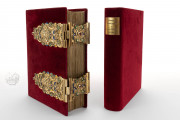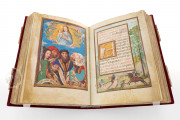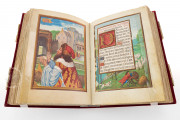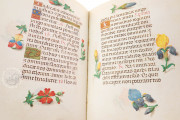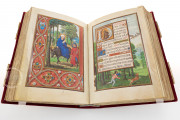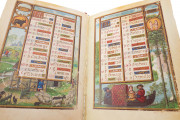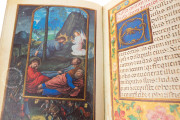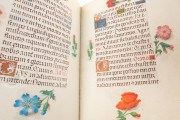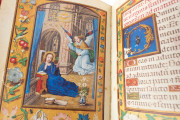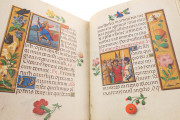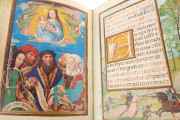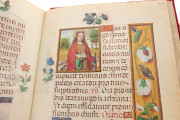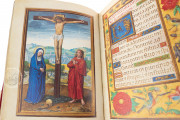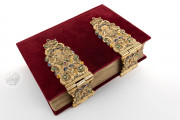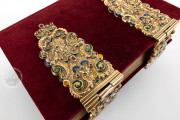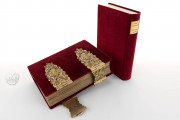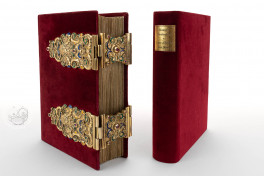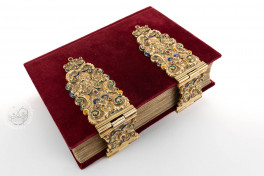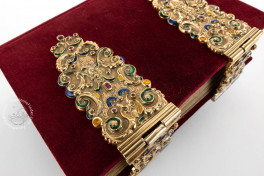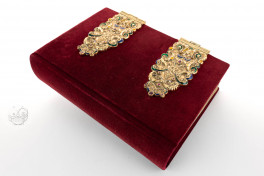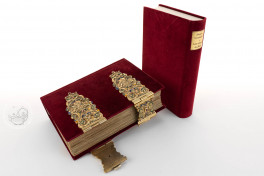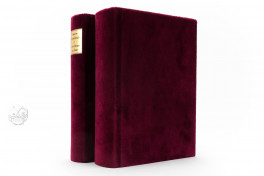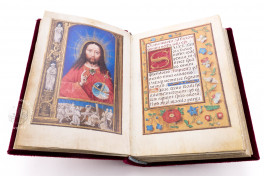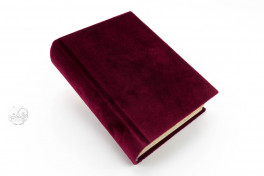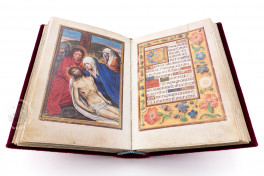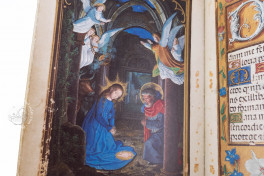Simon Bening's Flowers Book of Hours, a small book for use in Christian private devotions, was made between 1520 and 1525 in Ghent or Bruges. It takes its name from the floral motifs that occupy the margins of the pages that do not have fully painted borders. This jewel of a book is one of several surviving codices testifying to the status of its illuminator, Simon Bening, as one of the prime European artists of the sixteenth century and the prolific output of his workshop. Featuring the workshop's characteristic vivid palette and generous gold highlighting, the manuscript is decorated with sixteen full-page miniatures, twenty-six additional miniatures, and abundant painted borders.
The Book of Flowers is a book of hours in Latin. It begins with an illuminated calendar, showing the labors of the month along with the zodiac symbols in the fully painted borders, and continues with the prayers that are customarily found in the popular form of lay devotional literature known as the book of hours.
A Dynamic Visual Display
The major textual divisions of the book are marked by a full-page miniature, either appearing in a fictive wood frame or within a historiated or decorated border, facing a page of text with a painted initial and a fully painted border. The miniature of the Nativity (fol. 82v) embodies the atmospheric qualities for which Bening was renowned: the delicate glow from Mary’s halo illuminates the smoke wafting from the incense burners swung by the angels, creating a scene of compelling mystery. The collection of images demonstrates Bening's expressive range. The rushing charge of the ominous nocturnal scene of the Arrest of Christ in the historiated border of the Agony of Garden (fol. 16v), for example, contrasts with the calm of the central scene.
Lush Flourishing Texts
The effusive embellishment is naturally extended to the text, as the border of every single page of the elegantly penned Gothic Textualis script features a selection of painted gems, jewelry, flowers, insects, and other small animals. The line fillers are composed of the same fleshy acanthus leaves used to construct the elaborate decorated initials.
Bound in Gems and Enamel Inlay
The luxurious binding of the Flowers Book of Hours dates from around 1600. The black leather cover provides the perfect ground for the magnificent gold-plated silver clasps to shine. Featuring elaborate garland motifs, these oversized clasps are decorated with colorful enamel inlays and gemstones. Numbering sixty-four gems and inlays on the front and sixty-three on the back, the sumptuous decoration of the binding heralds the codex's sumptuous illumination.
An Unknown Patron
The Flowers Book of Hours contains no clues that might reveal its original owner. The book is first described in the inventory of decorated books transferred from the Schatzkammer (treasury) of Karl Theodor Wittelsbach (1742-1799), Elector of the Palatinate and Bavaria, to the Munich Hofbibliothek in 1785. The holdings of the Hofbibliothek, which were considerably expanded in the early nineteenth century, formed the foundation collection of the Hof- und Staatsbibliothek in 1829, renamed the Bayerische Staatsbibliothek in 1919.
We have 2 facsimiles of the manuscript "Simon Bening's Flowers Book of Hours":
- Blumen-Stundenbuch von Simon Bening (Deluxe Edition) facsimile edition published by Faksimile Verlag, 1991
- Blumen-Stundenbuch von Simon Bening (Standard Edition) facsimile edition published by Faksimile Verlag, 1991


